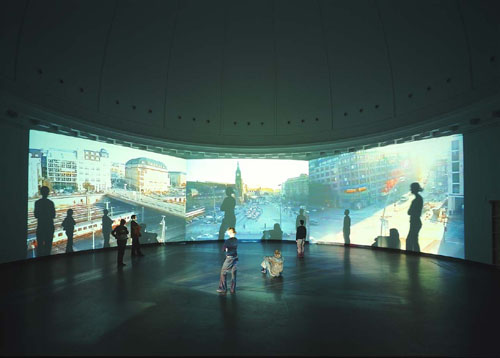MONA HATOUM @ HAMBURGER KUNSTHALLE (26 MARCH - 31 MAY 2004), KUNSTMUSEUM BONN (17 JUNE - 29 AUGUST 2004) AND MAGASIN3, STOCKHOLM (9 OCTOBER - 19 DECEMBER 2004).

This exhibition is to all intents and purposes a retrospective. It presents extensive documentary material about the early performances of Mona Hatoum and provides an overview of her works and her artistic concerns. It shows how certain themes have continuously been developing over the past 25 years.
Exactly one floor below Lookout stands Corps étranger, 1994, a cylindrical space, in which circular images are projected onto the floor. The view turns from the panoramic to the intimate. The images are the filmic account of an examination of the artist’s body with the help of an endoscope, they detail the surfaces and provide views from deep within all orifices, altering perspective and proportion and thus charting the human body as unknown territory.
Hatoum often modifies the scale of objects in her work, to allow for a perception that is not clouded by preconceptions, and naturally also to invest them with a new layer of meaning. Her enlarged household objects - the graters in a Grater Divide, 2002, or the birdcage in Cage-à-deux, 2002 - are quite discomfiting structures, emanating a strong sense of danger and threat, with a life beyond the mundane.
Thus the enlarged birdcage, with its two feeding bowls and the size and appearance of a four-poster bed, can also be seen as a representation of the confinements of relationships, as human interactions and relations are one of the currents in Hatoum's work. She regularly provides visualisations for the abyss of innocence, trust and reliance: the sharpened edges of the two iron swings in Balençoires en fer, 1999, would severely cut into the legs of every couple using them, while the handles of the steel wheelchair in Untitled (wheelchair), 1999, are forged into knife-blades, threatening to wound anyone willing to help.
Hatoum's installation Homebound, 2000, also transforms the ordinary. Metal household objects are wired up and connected to bulbs, which light up whenever the humming sound of a strong electric current can be heard. Though the installation of this work is far from ideal - compared to previous installations at Documenta or at Tate Britain, it is too withdrawn into its own cabinet - it still arouses strong associations of torture and pain. The wire cages of Light Sentence, 2002, also inevitably recall images of maltreated birds in hen batteries, though these cages were originally used much more innocently as lockers in a factory.
Central to the exhibition is the video piece Measures of Distance, 1988, in which Hatoum layers different strata of personal information. The visual basis is a film she took of her mother, naked behind a shower curtain; this is then superimposed with photographs of her mother's letters to her in Arabic. One soundtrack is of the discussions between the two at the time when the film was shot, the other an English reading of her mother's letters. As her mother is quite frank in the discussion of sexuality, the video tackles a variety of taboos. It also provides an autobiographical background for some of the pieces in the exhibition, which comment on the situation in Palestine.
Present Tense, 1996, is one of them. It was created on a visit to Israel and Palestine, and is made of little blocks of soap from Nablus, laid out in a large rectangle on the floor. In these, the outlines of the Palestine territories are inscribed with little red beads. When this piece was made, it provided a powerful comment on Palestinian autonomy, as the materials used were traditional to the area. Now, it has become an accusation, since the factory where the soap was produced has been bombed and destroyed.
Every time one looks at this piece, it will have changed; every time, additional information will have changed our perception. It is a process, that brings the outside world into the four white walls of the gallery.
